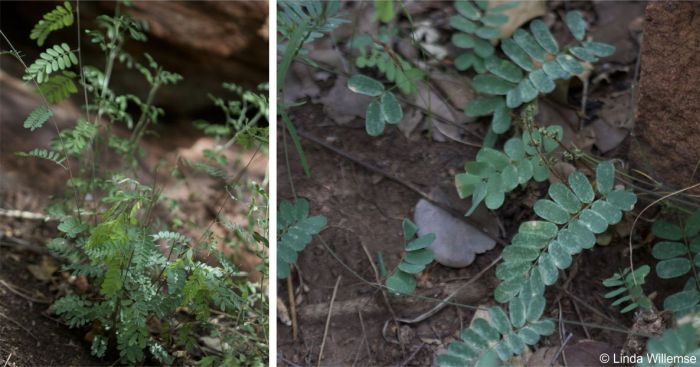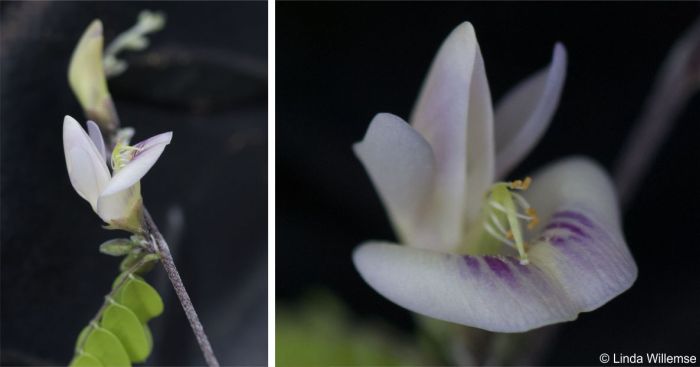Abrus laevigatus
Abrus laevigatus E. Mey.
Family: Fabaceae
Common names: luckybean creeper (Eng.); minnaarsboontjie, minnie-minnies (Afr.); umphitsi (isiZulu)
Introduction
Luckybean creeper is a climbing shrub, with long, slender stems, mauve to cream flowers in summer, and brown or black seeds. It is widespread in South Africa and in tropical and subtropical regions. There are some species similar to it and this may cause confusion.

Description
Description
Abrus laevigatus is a shrub, with slender, wide-climbing, woody branches, sparsely covered in yellow hairs, up to 6 m long. Leaves are pinnate and alternate. Leaflets are 6-10-paired, opposite. Leaflet stalks are short, blades oblong or obovate-oblong, 5–30 × 3–10 mm, membranous, sparsely white bristly or densely white hairy below, hairless or hairy above, rounded or heart-shaped at base, flat and with mucro at the tip. Flowers are in dense, several-flowered racemes, borne in leaf axils, 30–100 mm long. Flowers are 3-9 mm long. Sepal cup is bell-shaped, 4-toothed, white-bristly or densely grey-hairy. Flowers are white, lilac or mauve. Seed pods are oblong, 50–65 × 8–15 mm, densely white-hairy, splitting open, with 4–12 seeds. Seeds are black to brown or black, lustrous to slightly lustrous, elliptic or ovoid, compressed. Flowering time is in summer, from September to May.

In South Africa, it may be confused with Abrus precatorius, known as luckybean creeper or jecquirty bean, its flowering branches are often bare where those of A. laevigatus are leafy. They are easily told apart when in fruit, the pods of A. laevigatus are longer and narrower and a single pod, whereas those of A. precatorius are in clusters.
Conservation Status
Status
Abrus laevigatus is listed in the 2009 Red List of South African plants (Raimondo et al. 2009) but has no threat status.
Distribution and habitat
Distribution description
Abrus laevigatus is a common plant in 7 South African provinces: Limpopo, North West, Gauteng, Mpumalanga, KwaZulu-Natal and Eastern Cape, it also occurs in eSwatini (Swaziland) and in many tropical areas of the world. It is a common weed of roadsides, old gardens, disturbed sites, waste areas and waterways (i.e. riparian areas) in the higher rainfall regions of subtropical areas.

Derivation of name and historical aspects
History
The name Abrus is derived from the Greek word abros, which means ‘delicate’ and refers to the leaflets; laevigatus is derived from Latin, levis, meaning ‘smooth’ or ‘polished’.
Ecology
Ecology
Luckybean creeper reproduces mainly by seed. These seeds are thought to be mostly dispersed by birds, but it is likely that they are also spread along waterways during floods and in dumped garden waste.

Uses
Use
Abrus laevigatus is used for the same medicinal purposes as Abrus precatorius. The extract of the root of the plant is used to relieve eye diseases, and to treat tapeworm infestation, bilharzia, asthma and gonorrhea.
Growing Abrus laevigatus
Grow
Abrus laevigatus is propagated by seed, which germinates if soaked in water. One can also place cuttings of strong shoots in sand and keep damp with plastic cones.
References
- Bailey, L.H. & Bailey, E.Z. 1976. Hortus third, edn 1: 3. Macmillan, New York.
- Boon, R. 2010. Pooley's trees of eastern South Africa, a complete guide. Flora & Fauna Publications Trust, Durban.
- Bruneton, J. 1999. Toxic plants: dangerous to human and animals, edn 1: 287. Lavoisier Publishing, France.
- Dreisbach, R.H. 1971. Handbook of poisoning, edn 7: 422. Lange Medical Publications, Canada.
- Hardin, J.W. & Arena J.M. 1974. Human poisoning from native and cultivated plants, edn 2: 82. Duke University Press, Durham, North Carolina.
- Harvey, W.H. 1894. Abrus laevigatus E.Mey. Flora capensis, Vol 2: 263. Accessed via BHL. https://www.biodiversitylibrary.org/item/15233#page/271/mode/1up.
- Kagra, S. & Dahiya, K.L. Abrus laevigatus, Abrus pulchellus , Abrus strictosperma. http://allpedia.dkart.in/herbal-plants/11736-abrus-laevigatus-abrus-pulchellus-abrus-stictosperma.html
- Moll, E., Moll, G, & Strebel, R.C. 1989. Poisonous Plants, edn 1: 19. Struik, Cape Town.
- Oliver, D. 1871. Abrus pulchellus Wall. Flora of tropical Africa, Vol 2. Accessed via JSTOR. https://plants.jstor.org/compilation/Abrus.laevigatus.
- Raimondo, D., Von Staden, L., Foden, W., Victor, J.E., Helme, N.A., Turner, R.C., Kamundi, D.A. & Manyama, P.A. (eds) 2009. Red list of South African plants. Strelitzia 25. South African National Biodiversity Institute, Pretoria.
- Watt, J.M. & Breyer-Brandwijk, M.G. 1962. The medicinal and poisonous plants of southern and eastern Africa , edn 2. Livingstone, Edinburgh & London.
Credits
Thabo Masupa
National Herbarium, Pretoria
August 2021
Acknowledgements: to the author sincerely thanks Linda Willemse and Geoff Nichols for capturing the images of Abrus laevigatus used in this article.
Plant Attributes:
Plant Type: Climber, Shrub
SA Distribution: Eastern Cape, Gauteng, KwaZulu-Natal, Limpopo, Mpumalanga, North West
Soil type: Sandy, Loam
Flowering season: Early Summer, Late Summer
PH:
Flower colour: White, Cream, Mauve/Lilac
Aspect: Full Sun, Morning Sun (Semi Shade), Afternoon Sun (Semi Shade)
Gardening skill: Average
Special Features:
Horticultural zones









Rate this article
Article well written and informative
Rate this plant
Is this an interesting plant?
Login to add your Comment
Back to topNot registered yet? Click here to register.